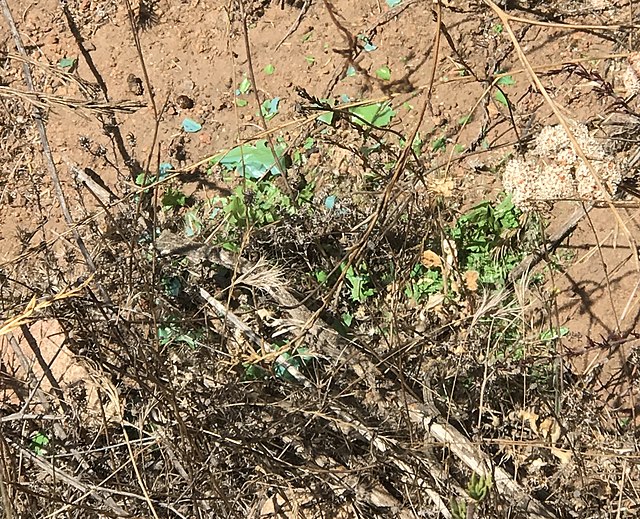Loading AI tools
来自维基百科,自由的百科全书
根据美国国家海洋暨大气总署(NOAA)[1][2]和欧洲化学品管理局(ECHA)[3]的定义,微塑料是指直径小于5毫米的塑料颗粒。来源多种(包括化妆品、服装、食物包装和工业流程),当其进入自然生态系统后会造成污染。

而“大型塑料(macroplastics )”这个名词是用于描述较大的塑料垃圾(例如塑料瓶),以与微塑料有所区分。目前公认的微塑料分为两种 -“ 初级微塑料” ,是在进入环境之前尺寸已是5.0毫米或更小的塑料碎片或是颗粒(包括来自衣服的微纤维、柔珠和塑胶颗粒(Nurdle))。[4][5][6]“ 二次微塑料”,则是较大塑料进入环境后,经风化而降解(分解)者。二次微塑料的来源有水瓶和汽水瓶、渔网、塑料袋、微波用容器、茶包和车辆轮胎磨损所产生者。[7][6][8][9]这两种微塑料都以大量形式持续在环境中存在,特别是在水域生态和海洋生态系统之中,会造成水污染。[10]海洋微塑料中有35%来自纺织品/服装,主要是由于聚酯、腈纶或尼龙纤维为主原料服装的磨损,通常是在洗涤过程中发生。[11]微塑料也会在空气和陆地生态系统中累积。
由于塑料的降解缓慢(通常需要数百年至数千年),[12][13]微塑料也会被许多生物体的身体和组织摄入及掺入,之后产生生物积累。来自海洋和地表径流的有毒化学物质也可在食物链中产生生物放大作用。[14][15]微塑料已被证明会在陆地生态系统中降低土壤生态系统的活力,及降低蚯蚓的体重。[14][15]微塑料在环境中的循环和运动尚未被清楚了解,但目前已进行研究以调查此现象。中国在2020年对深层海洋沉积物调查的结果,显示其中有塑料存在,时间远在塑料发明之前,因此对海洋表层采集样本调查时,产生是否微塑料会有遭低估的疑问。[16]甚至在远离源头的高山中也发现有微塑料存在。 [17]



“微塑料”这个名词于2004年由英国普利茅斯大学海洋生物学家理查·汤普生教授提出。[20][21][22]
微塑料在现代世界里普遍常见。估计在2014年当时的世界海洋中有15到51兆个微塑料颗粒,重量在93,000到236,000公吨之间。[23][24][25]


通常初级微塑料是刻意制成的小粒塑料。[26]加入洗面乳和化妆品中,或用于喷砂作业。也有关于作为医学药物载体的报导。[27]含有微塑料的“洗涤剂”,用作去角质洗手液和脸部磨砂膏,已取代传统上使的天然成分(例如磨碎的扁桃壳、燕麦片和浮石)。用于喷砂的初级微塑料,是在机械、发动机和船体上喷以含有腈纶、三聚氰胺或聚酯微塑料的洗涤剂,用来去除锈迹和油漆。这些洗涤颗粒被反复使用,直到尺寸变小,且丧失切割功能,这些颗粒经常受到镉、铬和铅等重金属的污染。[28]许多公司已承诺减少柔珠的产量,但许多取而代之的生物塑料柔珠仍具有较长降解的生命周期。[29]
二次塑料是由较大的塑料废弃物分解而成的小片塑料。在时间演进之中,历经物理、生物和化学光降解(包括由阳光照射引起的光氧化),这些碎片的结构最终降低到肉眼无法察觉到的大小。 [30]这种过程称为破碎化(fragmentation)。[28]微塑料被认为会再进一步降解成尺寸更小的程度,但据报导,目前在海洋中检测到最小微塑料的直径为1.6微米(6.3×10−5英寸)。[31]破碎化持续进行是导致各处普遍均有各式形状微塑料的原因。 [14]据观察,无论在海水或是淡水中,由可生物降解聚合物所形成的微塑料数目,远高于由不可生物降解聚合物所形成的。[32]
产生初级和二次微塑料的来源有无数种。合成材料衣物经洗涤后,会产生塑料微粒,并进入环境。[33][8]含有合成丁苯橡胶的车辆轮胎在运行过程中会因磨损,而成为微小的塑料和橡胶颗粒。此外,用于制造其他塑料产品时而产生的2.0-5.0毫米的塑料颗粒,由于溢出和其他事故而进入生态系统。[6]挪威环境局在2015年初发布一份关于微塑料的审查报告[34]中指出,把这些来源归类为主要来源较为清楚,只要这些微塑料是人类社会自“管道源头”就开始发生,并且本质是人类使用材料和产品的结果,而非在自然界中的再次破碎化而成。
根据使用中的定义,纳米塑料的尺寸小于1微米或小于0.1微米。[35] 对环境中纳米塑料有多种臆测,从微塑料破碎过程中的短暂副产品,到其具有高度和不断上升的浓度,之后成为一种无形的环境威胁。[36]在北大西洋马尾藻海中已证实有纳米塑料存在。[37]拉曼光谱与光镊(拉曼镊子(Raman Tweezers))[38]以及纳米傅立叶转换红外光谱或原子力红外线纳米光谱在不久的将来有甚大机会可作为测量环境中纳米塑料数量的工具。萤光是种独特,可用来识别纳米塑料和将其量化的工具,可因此而开发出快速、简单、廉价和灵敏的方法。[39]
纳米塑料被认为会对环境和人类健康构成威胁。由于尺寸极小,可穿过细胞膜而影响细胞的功能。纳米塑料具有亲脂性,电脑模型显示聚乙烯纳米塑料可掺入磷脂双分子层的疏水效应核心。[40]纳米塑料还被证明可穿过鱼的上皮细胞膜,在胆囊、胰脏和大脑等器官中累积。[41][42]关于纳米塑料对生物体(包括人类)的不良健康影响,目前知之甚少。在斑马鱼中,聚苯乙烯纳米塑料可诱导改变葡萄糖和皮质醇水准的压力反应途径,这可能与压力阶段的行为变化有关联。 [43]聚苯乙烯纳米塑料被淡水水蚤摄入,其生长和繁殖会受到影响,并诱导压力防御,包括活氧性产生,并影响其MAPK-HIF-1 / NFkB介导的抗氧化系统。[44][45][46]
大多数微塑料污染的来源是纺织品、轮胎和城市灰尘,这些在环境中微塑料的占比达80%以上。[10]微塑料的存在通常是透过水生研究来确定。包括采集浮游生物样本、分析沙质和泥质沉积物、观察脊椎动物和无脊椎动物的摄食,以及评估化学污染物的相互作用。[47]通过这样的方法,显示出环境中存在多个微塑料的来源。
根据2017年国际自然保护联盟的报告,微塑料占太平洋垃圾带污染的比例高达30%,在许多发达国家,微塑料在污染海洋的来源上比可见的大块海洋垃圾占更大的比率。[6]
由于轮胎会磨损,导致极大量(微)塑料进入环境。估计丹麦每年排放进入环境的微塑料在5,500至14,000公吨之间。二次微塑料(例如来自汽车和卡车轮胎或鞋类的磨损)比初级微塑料多了两个数量级。这项研究未把环境中较大塑料降解而形成的微塑料考虑在内。[48]
估计人均道路相关磨损排放量在0.23至4.7公斤/年之间,全球平均水平为0.81公斤/年。汽车轮胎(磨损达到100%)的排放量远高于其他相关的微塑料来源,例如飞机轮胎(2%)、人造草坪(磨损12-50%)、刹车片(磨损8%)和路面标记(磨损5%)。就路面标记而言,最近的实地研究,显示因有一层玻璃珠的保护,它们产生的数量仅为0.1至4.3克/人/年,[49]在所有二次微塑料污染排放中的占比仅为0.7%。此数值与另一些估计结果一致。[50][51]
排放和途径取决于当地道路类型或污水处理系统。据估计,全球轮胎磨损在最终流入海洋的塑料中占比为5-10%。估计在空气中有3–7%的悬浮微粒 (PM2.5) 源自轮胎磨损,对于世界卫生组织(WHO)预测全球在2012年有300万人因悬浮微粒而死亡的结果,轮胎磨损也是元凶之一。轮胎磨损造成的污染也会进入食物链,但需进一步研究,以评估其对人类健康的风险。[52]
研究显示许多合成纤维,如聚酯、尼龙、腈纶和氨纶,会从衣服上剥落而持续在环境中存在。[53][54][55]每件衣服都会脱落1,900多根微塑料纤维,其中羊毛脱落的纤维的数量最高,比其他材料多出170%。[56][57]每次平均洗涤6公斤(13磅)衣物,可释放超过700,000根纤维。 [58]
洗衣机制造商还对洗衣机做过是否可降低超细纤维排放量的研究,以降低事后污水处理厂的处理工作。[59]
这些微纤维被发现存在于从浮游动物起到大型动物(如鲸鱼)的整个食物链中。[6]贯穿整个纺织行业的主要纤维是聚酯,它是种廉价的棉花替代品,易于制造。但这类型纤维造成极大量微塑料在陆地、空中和海洋生态系统中持续存在。洗衣过程中使用每升水,平均会脱落超过100根纤维。[57]这可能与所释放的单体、分散染料、固染剂和塑化剂导致的健康影响有关联。这类纤维已被证明占室内环境中所有纤维的33%。[57]
对人类在室内和室外环境中的平均暴露量研究,发现室内的密度为1.0-60.0纤维/立方米,而室外密度则低得多,仅0.3-1.5纤维/立方米。[60]室内沉积速率为每天1,586-11,130根纤维/立方米,累积成为约190-670纤维/毫克的粉尘。[60]
一些公司使用微塑料以取代天然去角质成分,通常以“柔珠”或“微去角质”的形式出现。这些产品通常由常见的聚乙烯制成,但也可由聚丙烯、聚对苯二甲酸乙二酯 (PET) 和尼龙制成。[61]这些材料经常出现在洗面乳、洗手液和其他个人护理用品之中。这些小颗粒通常在使用后会立即被冲入污水系统。由于体积过小,无法完全被废水厂的初步滤网截留,而有些最终会进入河流和海洋。[62]事实上,由于污水处理厂的设计,平均只能去除95–99.9%的柔珠。随每升水排出的柔珠平均有0-7个。估计美国每天大约可处理160万亿升水,因此每天约有8兆微珠被释放到进入水道。这个数字不包括在废水处理后被重新用作肥料的污泥,已知这些污泥仍然含有柔珠。[63]
虽然许多公司已承诺逐步停止在产品中加入柔珠,但根据研究,至少有80种不同的脸部磨砂产品仍使用微珠作为主要成分。[64]导致仅英国就会每年会排放80公吨柔珠,不仅对野生动物和食物链产生负面影响,而且还会对毒性水准产生影响,因为柔珠已被证明会吸收危险化学品,例如杀虫剂和多环芳烃。[64]ECHA的限制提案以及联合国环境署 (UNEP) 和荷兰顾问公司TAUW的报告,均显示有超过500种微塑料成分被广泛用于化妆品和个人护理用之中。[65]
纵然把柔珠从从化妆品中去除,但其中仍有含有塑料。例如丙烯酸-丙烯酸酯共聚物(acrylates copolymer),受其污染后会对水道和动物造成毒性影响。[66]丙烯酸-丙烯酸酯共聚物在用于个人护理用品时也会释放苯乙烯单体,会增加人类罹患癌症的几率。[67]像新西兰般会禁止使用柔珠的国家,通常会忽略其他聚合物(例如丙烯酸-丙烯酸酯共聚物),这类物质对人类和环境同样有毒。[68]
休闲和商业捕鱼、海洋船舶和海洋产业都是塑料的来源,直接进入海洋环境,既包括大型塑料,也包括长期降解后的二次微塑料,对生物群系构成威胁。在海滩上的海洋废弃物也是由近海和洋流带来的垃圾搁浅形成。渔具也成为海洋塑料废弃物的来源。丢弃或丢失的渔具,包括塑料单股渔线和尼龙渔网(有时称为幽灵渔网),通常具有中性浮力,因此可在海洋中不同的深度内漂浮。多个国家报告称在不同类型的海产品中,已有工业和其他来源的微塑料积累。在印尼,55%的鱼类身上均有人造废弃物的证据,类似于美国(占比则达到67%)。[69]然而在印尼的大部分废弃物是塑料,而在北美地区,大部分是在衣服和某些网类中的合成纤维。鱼类受微塑料污染的结果是这些塑料及其化学物质将在食物链中作生物累积。
一项研究对短尾水薙鸟胃中称为多溴二苯醚 (PBDE) 的塑料衍生化学物质做分析。研究发现其中四分之一含有高溴化同系物,而这些同系物在鸟类的猎物中并非天然存在。既然在鸟类胃中发现有此类化学物质。即表示透过食物链转移的不仅是塑料,还有塑料中的化学物质。[70]
塑料制品通常是以颗粒材料和小树脂颗粒来制作。2019年的世界塑料产量为3.68亿吨;51%在亚洲生产。中国是世界上最大生产国,占世界总量的31%。[71]这些原材料由于在陆路或海上运输过程中发生意外而泄漏、不妥的包装以及从加工厂直接流出,会进入水域生态系统。瑞典环保组织KIMO Sweden使用80微米网眼的筛网对瑞典水域进行评估时,发现典型的微塑料密度为每立方米150-2,400个微塑料。在塑料生产设施附近的港口,密度则为每立方米102,000。[28]
许多经常使用塑料作原料的工业场所都位于交通方便的水体附近。如果在生产过程中发生溢出,这些材料就会进入周围环境,而污染水道。[34]“最近美国化学理事会和塑料产业协会提出一项联合倡议 - Operation Cleansweep ,目的在促使整个产业的业者承诺在其运营过程中实现零颗粒损失。”[28]但总体而言,针对会导致微塑料污染的特定产业和公司的研究非常缺乏。
航运是造成海洋污染的重要原因。一些统计数据显示在1970年,世界各地的商业船队向海洋环境倾弃超过23,000吨塑料垃圾。在1988年签订的《防止船舶污染国际公约(MARPOL 73/78,附 V)禁止船舶把废弃物倾倒进入海洋环境。美国在1987年通过的海洋塑料污染研究和控制法案( Marine Plastic Pollution Research and Control Act of 1987)禁止船舶(包括海军舰艇)在海中排放塑料。 [72][73]但航运业仍是塑料污染的主要来源,在1990年代初期即倾弃约650万吨塑料进入海洋。[74][75]研究显示在夏威夷海滩上发现的塑料中约有10%是塑料颗粒。[76]在2012年7月24日,香港经历一场大风暴后,有150吨塑料颗粒和其他塑料原料从附近海岸的船上溢出。据报导,这批来自中国石化公司的塑胶废弃物大量堆积在海滩上。[34]这事件是一起大型泄漏事件,研究人员推测还有更小的事故发生,而进一步加剧海洋微塑料污染。[34]
自COVID-19大流行出现以来,医用口罩使用量急剧增加。一次性口罩由聚合物如聚丙烯、聚氨酯、聚丙烯腈、聚苯乙烯、聚碳酸酯、聚乙烯或聚酯制成。口罩的生产、消费和事后乱扔的情况增加,导致环境中塑料废弃物增加,为环境污染增添挑战。一次性口罩经降解后可分解成更小的颗粒(小于5毫米),成为新的微塑料来源。[77]
致力于倡导和研究海洋污染的组织Oceans Asia于2020年2月发布的报告证实,“香港周围的海洋中已存在不同类型和颜色的口罩”。[77]
有项对11种不同品牌的瓶装水做研究,其中93%显示有微塑料污染。研究人员发现平均每升有325个微塑料颗粒。[78]在受测品牌中,雀巢的Pure Life和德国品牌Gerolsteiner的微塑料含量最高,分别为每升930和807个微塑料颗粒 (MPP/L)。[78]意大利品牌圣沛黎洛的微塑料密度最低。瓶装水含微塑料的数量为自来水的2倍。一些污染可能是在装瓶和包装时发生。[78]

研究人员在2020年报告称,在48个地区,采用现代制备生产的聚丙烯婴儿奶瓶会导致婴儿人均每天接触14,600至4,550,000个微塑料颗粒。受较热的液体影响,奶瓶会释放更多的微塑料,与其他聚丙烯产品(如午餐盒)类似。[79][80][81]意外的是研究人员在2021年发现,硅氧树脂婴儿奶瓶的奶嘴会因反复以蒸汽灭菌而退化,而脱落微米级和纳米级的硅氧树脂颗粒。据估计,婴儿使用这种热降解的奶嘴,一年内会摄入超过660,000个颗粒。[82][83]

普通的一次性塑料制品 - 例如内部衬有塑料薄膜的纸质咖啡杯 - 在正常使用过程中每升会释放数兆个微塑料纳米颗粒进入杯中。[84][85]一次性塑料产品会让微塑料进入水生环境,[86]“在地方及州层级制定政策以减少一次性塑料使用,是有效解决塑料污染的做法”。[87][88]
污水处理厂,(Sewage treatment,也可写为wastewater treatment plants (WWTP))会利用各种物理、化学和生物程序去除污水(主要是生活污水)中的污染物。[89]发达国家的大多数工厂都有初级和二级处理设施。在初级处理,会使用传统的过滤装置、澄清装置和沉淀池去除油、砂和其他大的固体。 [90]二级处理使用涉及细菌和原生动物的生物过程来分解有机物。常见的二级技术是活性污泥系统、滴滤池和人工湿地。 [90]可选用的三级处理可包括去除营养物(氮和磷)和消毒的程序。[90]
在污水处理厂中的初级和二级处理时都可检测出微塑料。在1998年所做的一项开创性研究显示,污泥和废水处理厂排放口的微塑料纤维将成为一种持续性指标。[91]一项研究估计,当去除效率约达99.9%时,每升水中约有一个塑料颗粒会被释放回环境中,。[89][92][93]在2016年所做的一项研究显示,大多数微塑料实际上是在初级处理阶段时,已受固体撇渣和污泥沉淀程序而去除。[89]当污水处理厂的处理设施正常运行时,进入海洋和地表水环境的微塑料数量不会特别大。[89][94]
有些国家会用污泥作肥料使用,而让存在污泥中的塑料暴露在天气、阳光和其他生物因素下,导致破碎化。而包含在这些生物固体的微塑料通常最终仍会进入雨水渠,再进入水体。[95]此外,一些研究显示微塑料确实会穿过某些污水处理厂的过滤设备。[28]根据英国一项从六大洲沿海污水污泥处置场采样的研究,平均每升含有一个微塑料颗粒。这些颗粒有很大部分是洗衣机排水中的纺织品纤维。[57]
根据欧盟科学咨询机制在2019年发布的科学证据综合审查,现在环境中每处均有微塑料存在。虽然目前尚无证据显示微塑料污染会带来广泛的生态风险,但如果以目前的增长速度持续下去,风险可能会在一个世纪内普遍发生。 [96]
2008年在华盛顿大学塔科马校区举行名为微塑料海洋垃圾的发生、影响和归宿国际研究研讨会(International Research Workshop on the Occurrence, Effects and Fate of Microplastic Marine Debris),参与者[97]的结论认为微塑料是海洋环境中的一个问题,原因为:
迄今的研究主要是集中在较大的塑料制品上。海洋生物面临的广泛问题是缠绕、吞食、窒息和通常因身体衰弱而造成的死亡和/或搁浅,而引起公众的严重关注。相较下,微塑料小于5毫米,通常肉眼看不见,不起眼。这种尺寸的颗粒会受到更广泛的物种摄入,从食物链底层渗入而嵌入动物组织之中,却无法透过肉眼检测。
此外,塑料降解和长期释放污染,其后果大多受到忽视。目前环境中已有大量塑料,在逐步降解之中,经过多年的崩解后会释放出有毒化合物,这现象被称为毒性债务(toxicity debt)。[36]
微塑料不仅存在海洋中,在淡水系统中也可检测到微塑料,包括(欧洲、北美洲、南美洲、亚洲和澳大利亚)的草沼、溪流、池塘、湖泊和河流。[98][99]从美国六个州的29个五大湖支流所收集的样本中均发现含有塑料颗粒,其中98%是微塑料,尺寸从0.355毫米到4.75毫米不等。[100]
微塑料可经摄入或呼吸而后嵌入动物的组织中。各种环节动物,例如以沉积物为食的沙虫 (Arenicola marina),已被证明在消化道中嵌有微塑料。许多甲壳动物,如普通滨蟹(Carcinus maenas),已被发现有微塑料整合到它们的呼吸道和消化道中。[54][101][102]塑料颗粒经常被鱼误认为食物,它们的消化道会受阻塞,而向大脑发送不正确的进食信号。 [10]但新的研究显示鱼是无意间,并非有意摄入微塑料。[103]

有些珊瑚,如疣鹿角珊瑚也被发现会摄取微塑料。 [104]微塑料可能需要长达14天才会通过(正常消化期为2天),但纠结在水生动物鳃中的颗粒就无法完全去除。 [101]当身上有微塑料的动物被捕食者吃掉时,微塑料就会被纳入更高营养级捕食者的体内。例如科学家报告说灯笼鱼的胃里有塑料堆积,灯笼鱼是小型滤食动物,是鲔鱼和剑旗鱼等商业鱼类的主要猎物。[105] 微塑料还会吸收转移到生物体组织中的化学污染物。[106]由于微塑料会让这些小动物误认自己已吃饱,而导致饥饿或其他身体伤害(包括死亡)的风险。。
在阿根廷海岸线拉布拉他河口进行的一项研究发现,11种沿海淡水鱼的内脏中存在微塑料。这11种鱼类代表四种不同的摄食习性:食碎屑性、食浮游生物性、杂食性和食鱼性。[107]这项是迄今为数不多,显示淡水生物摄入微塑料的研究之一。
底栖摄食者如海参等是非选择性食腐动物(以海底废弃物为食),会摄取大量沉积物。已发现四种海参(Thyonella gemmate、Holothuria floridana、H. grisea和Cucumaria frondosa),根据每次摄入沉积物中的塑料与沙粒的比例,它们摄入的聚氯乙烯(PVC)碎屑增加2到20倍,尼龙线碎屑增加2到138倍(每个生物体有517根纤维)。这些结果显示海参可能会选择性摄入塑料颗粒。这与公认的海参不分青红皂白的喂食策略有冲突,并且可能同样会发生在所有假定的非选择性摄食者中。[108]
双壳类动物是重要的水生滤食动物,也被证明会摄取微塑料和纳米塑料。 [109]当接触微塑料后,这类类动物的过滤能力会下降。[110]结果发生多重级联效应,例如免疫毒性和神经毒性。 [111][112][113]由于吞噬作用和NF-κB基因活性降低,导致免疫功能下降。[111][113]神经功能受损是ChE和神经递质调节酶受抑制的结果。 [113]当双壳类动物暴露于微塑料时,也会经历氧化应激,显示体内化合物解毒的能力受损,最终会损害 去氧核糖核酸(DNA)。[112]双壳类的配子和幼虫暴露于微塑料时,也会受损。发育停滞率和发育畸形率增加,而受精率下降。 [109][114]当双壳类动物在实验室环境中暴露于微塑料以及其他污染物(例如持久性有机污染物(POPS)、汞或碳氢化合物)时,毒性作用会加剧。[110][111][112]
不仅鱼类和自由活动的生物体会摄取微塑料。连礁岩的主要组成者石珊瑚已被证明会在实验室条件下摄取微塑料。[115]虽然尚未对摄入的影响做过研究,但珊瑚容易变得紧张和惨白。在实验室经暴露后,微塑料会粘附在珊瑚的外部。[115]粘附在珊瑚外部可能有害,因为珊瑚无法处理其体外的沉积物或悬浮微粒,也无法分泌粘液将其剥离,在此过程中会消耗能量,增加死亡的可能性。[116]
海洋生物学家在2017年发现,在伯利兹海岸外的通妮芙环礁,四分之三的水底海草上粘有微塑料纤维、碎片和珠子。塑料件上长满外生生物(自然粘附在海草上的生物)。海草是珊瑚礁生态系统的一部分,鹦哥鱼以其为食,而鹦嘴鱼又是人类的食物。这些发现发表在《海洋污染公报》上,可能是“首次在水生维管植物上发现微塑料……[并且]是在世界任一处海洋植物中第二次发现微塑料。”[117]
受到伤害的不仅是水生动物。微塑料会阻碍陆生植物和蚯蚓的生长。[118]
在2019年,欧洲普通蝾螈 (Triturus carnifex) 首次被报导其胃中内容物里面发现有微塑料。这也是全球有尾目动物的首个证据,强调即使在偏远高海拔的环境中,新出现的塑料问题仍是种威胁。 [119]
浮游动物摄取微塑料珠 (1.7–30.6毫米) 并排泄含有微塑料的粪便。跟随摄入,微塑料会粘附在浮游动物的附肢和外骨骼上。[120]浮游动物和其他海洋生物会摄食微塑料,因为微塑料会释放出类似的信息化学物质,特别是二甲硫醚,如同浮游植物发出的一样。[121][查证请求][122]常用于制作塑料袋、食品储存容器和瓶盖的塑料,如高密度聚乙烯 (HDPE)、低密度聚乙烯 ( LDPE) 和聚丙烯 (PP) [121]均会产生二甲硫醚气味。 [123]在浮游生物和海藻中发现有绿色和红色的塑料细丝。[124]
不仅动植物会摄取微塑料,一些微生物也生活在微塑料表面。根据一项在2019年所做的研究,这种微生物群落形成一层黏性的生物薄膜,[125]这种独特的结构具有特殊的风险,因为微塑料生物薄膜已被证明可提供新的定殖栖息地,增加不同物种之间的重叠,因此会经水平基因转移而传播病原体和抗生素抗药性基因。而后由于水道的快速移动,这些病原体会非常迅速从起源地移动到并无自然存在特定病原体之处,导致疾病传播。[125]
根据欧盟科学咨询机制在2019年发布的科学证据综合审查报告,“人们对纳米塑料和微塑料对健康的风险知之甚少,已知的部分则充满相当大的不确定性”。审查的作者将主要局限性确定为当前的研究品质或方法。评论的结论认为由于“毒药由剂量决定”,“在得出关于‘真实’人类风险的可靠结论之前,有必要了解在精心挑选的人体模型中,由不同大小形状类型的N-甲基吡咯烷酮(NMP)组合的潜在毒性模式可达到的程度。[96]
目前人类摄入微塑料的平均/中位数量被认为尚处于安全的水准;但有些人有时可能会超过这些限制;其影响(如果有的话)尚未知。[76]目前尚不清楚微塑料是否,以及在何种程度上在人体内作生物累积。[126][127]2022年的研究报告首次发现22名健康志愿者中有17人的血液中存在聚合物。塑料颗粒的总可量化密度平均值为1.6毫克/升。该研究的既定目的是开发一种取样和分析方法,用于检测人体血液中的塑料。[19]
最近的一项亚慢性研究,调查食品中甲基丙烯酸甲酯基底的聚合物微珠(> 10微米(用于治疗目的),发现除胃肠道外,并无在小鼠其他器官中发生生物累积的迹象。[128]鱼类和甲壳类动物摄入的微塑料随后作为食物链的末端被人类摄入。[129]微塑料存在于空气、水和人类的食物中,尤其是海鲜,但吸收和保留的程度尚不清楚。[130][126]通过食物摄入的微塑料可能相对较少。例如,虽然已知贻贝会积聚微塑料,但估计人类接触的家庭灰尘中微塑料会比食用贻贝摄取的更多。[131]
微塑料主要存在三个令人担忧的所在:塑料本身可能对人体生理有某种程度的影响,微塑料可能与环境中的重金属或其他化合物形成复合物,并作为带入体内的载体,而同时微塑料可能成为病原体的载体。[126]目前尚不清楚接触环境中的微塑料水准是否会对人类构成“真正的”风险;对这项主题的研究尚在进行中。
塑料颗粒可能会把附着在其表面的化合物(例如存在环境中,或是周围海水中持久性有机污染物(POPS)和新兴有机污染物)作[吸附]],以高密度度形式输送。[132]微塑料可作为从环境把POPs转移到生物体的载体。 [74][75]最近的文章还显示微塑料会吸附新兴有机化学品,例如药物和个人护理用品。 [133][134]吸附能力受水的基质、pH值、离子强度和微粒老化程度的影响。 [133]
在制造过程中使用的添加剂可能会在塑料摄入后渗出,而会对生物体造成严重伤害。添加剂中的内分泌干扰素会影响人类和野生动物的生殖健康。 [75]
从矿物油中提取的聚合物,绝大部分均无法生物降解。[135]以天然聚合物制造的塑料现正开发中,这些新材料可减少产品的碳足迹,降解后不会产生有毒物质,但仍有实用性,但成本方面的问题需要解决。[136]
在加拿大戴尔豪斯大学取得博士学位的史蒂夫·艾伦(Steve Allen)(一位在高山中发现微塑料研究报告的主要作者)说:“塑料从海洋中飞到那么高的空中 - 这表明此物质最终不会下沉。只是处于无止境的循环状态。”[17]
在大气中,以及室内外的空气中均可检测到微塑料。一项在2019年所做的研究发现微塑料会随风输送到偏远地区。 [137]一项在2017年所做的研究发现室内空气中的微纤维密度在每立方米1.0到60.0根之间(其中33%是微塑料)。[138]另一项针对德黑兰街道灰尘中微塑料所做的研究,在10个街道灰尘样本中发现有2,649个微塑料颗粒,样本密度范围为每30.0克灰尘中有83个至605个颗粒 (±10)。 [139]在雪的样本中也发现微塑料和微纤维,[140]在远离其源头的高山“清洁”空气中也发现有微塑料和微纤维。[17][141]就像针对淡水生态系统和土壤一样,需要进行更多的研究来了解空气中微塑料会产生的整体影响和程度。[96]
由于微塑料在人类日常生活用品中日渐普及,其对海洋生态系统产生的污染日益受到关注。微塑料是塑料珠,尺寸小于5毫米,[142]常见于洗手液、洗面乳和其他去角质产品之中。当这些个人护理用品被使用后,微塑料会穿过只做初步污水处理厂的过滤系统,而后进入海洋。[143]微塑料对海洋中生物(尤其是滤食性动物)有害,摄入之后会致病。由于微塑料的体积过小而难以清理,建议消费者以购买对环境安全的去角质产品为宜。
由于塑料受到广泛的使用,因此微塑料在海洋中也普遍存在。例如,在沙滩[144]和地表水,[[145]海洋中的水柱和深海沉积物中均可发现微塑料。在许多其他类型的海洋颗粒中也有微塑料存在,例如死亡的生物(组织和保护壳)和一些土壤颗粒(被风吹入河流,而后流入海洋)。即使在全球最深的海域马里亚纳海沟也有大量微塑料沉积,甚至明显高于其他海底沉积物的含量[146][147]。大洋区域的微塑料分布主要受到大洋环流和季风影响[148],已出现了多个范围较广的微塑料环流圈[149]。
微塑料进入海洋后,其命运取决于自然驱动因素,例如风和表面洋流。电脑模型能够追踪漂浮在海洋中的小塑料废弃物(微塑料和中型微塑料),[150]而预测它们最终将流往何处。
全球海水中微塑料的平均浓度在0.01-10个/m3[151]。人类活动的沿海区域均发现有微塑料的广泛分布[151],特别是河口地带[152]。
研究人员凯利等人(Kelly et al)在2009年从南极洲东部取样的冰芯中发现有96种微塑料颗粒,属于14种不同的聚合物 。[153]在此之前,南极洲的地表水和沉积物以及北极海冰中都有塑料污染的记录,但这次被认为是首次在南极海冰中发现有塑料污染。这些相对较大的颗粒显示是来自当地的局部污染源。[153]
微塑料已广泛在世界水生环境中被发现。[98][154]首项关于淡水生态系统中微塑料的研究于2011年发表,在休伦湖沉积物样本研究发现平均每平方米有37.8个颗粒。此外,同一研究也发现所有五大湖中均有微塑料,平均密度为43,000颗/升。[155]在美国以外的北美州淡水生态系统中也检测到微塑料。在加拿大,一项对温尼伯湖为期三年的研究,发现平均微塑料密度为193,420颗/升。检测到的微塑料都不是微片或是微珠,大多数是由较大颗粒、合成纺织品或大气沉降物分解所产生的纤维。[156]在研究过的淡水生态系统中发现的最高密度的微塑料是在莱茵河,为4,000颗/公斤。[157]
大气中的微塑料大小在200-700 μm,能依靠风力远距传输,并沉降到各种水体中[151]。通过大气传输的微塑料则会通过降雪进入高山和极地地区, 并在积雪中积累[151],从而有可能造成极地冰雪的加速升温和融化[158]。
虽说很大部分的微塑料预计最终会进入土壤之中,但迄今除对水生环境内的土壤有过研究之外,其余所做的却很少。[159]在湿地环境中,已发现微塑料密度与植被覆盖和茎密度呈负相关的情况。[98]有人猜测,由于水处理厂未能完全过滤掉所有洗衣机产生的微塑料纤维,这些微塑料可能最终是进入土壤。此外,蚯蚓、螨虫和跳虫等食土性土壤动物可经由消化过程,把摄入的塑料碎片转化为微塑料,而增加土壤中二次微塑料的数量。但仍需做进一步研究。有具体数据将有机废料的使用与土壤中发现的合成纤维做联系,但大多数对土壤中塑料的研究仅报告其存在,并未提及来源或数量。[6][160]使用对照研究,施用废水污泥(生物固体)于土壤,数年后会发现有不完全精确数字的微纤维存在。[161]
微塑料已进入我们的食物、水甚至是呼吸的空气中。据估计,人们每年会摄入超过50,000个塑料颗粒 - 如果把吸入列入考虑,数量会更多。[162]亚利桑那州立大学的研究生进行的研究,发现每个人体组织中都有微塑料存在。[163][164]于2022年3月发表的一项研究报告显示在22份匿名血液样本中,有80%存有微塑料,这表示微塑料可随血液在人体内循环,而提出它们是否会进入大脑的问题。 [165][166]在2020年12月,首次发生在未出生婴儿的胎盘中发现微塑料颗粒的纪录。[167][168]2022年6月,首次出现在母乳中有微塑料颗粒的纪录。[169][170]
世界上最贫穷和最脆弱的人群受到塑胶污染的影响最大。这些人口中的一部分主要在非正规废弃物部门工作和/或居住在露天垃圾场附近。
从介质中分离出微塑料一般需经过采样、预处理、浮选、过滤和消解这些步骤。水体中的微塑料常用拖网采集;土壤和沉积物中的微塑料采用金属器皿收集,大气中的微塑料多用气泵抽取或沉降收集。采集到微塑料后会先进行筛选,在进行浮选。然后将浮选出的上清液用滤膜进一步筛分。[151]
对采集到的微塑料进行分析鉴定,一般采用目视法、光谱法和热分析法等。目视法是通过放大镜或显微镜观察微塑料的外观特征;光谱法主要进行聚合物成分鉴定分析, 包括快速大面积拉曼光谱成像、衰减全反射傅里叶红外光谱成像和焦平面阵列红外光谱成像等。[151]
有研究人员提出焚烧塑料作为能源,称其为能量回收。把塑料埋入垃圾掩埋场的做法无法减少塑料的数量,塑料回收被认为是种更有效的解决方案。[76]
生物降解是另一种处理大量微塑料废弃物的解决方案。利用微生物通过酶消耗和分解合成聚合物。[171]处理过的塑料得以能源的形式使用,并在分解后作为碳源使用。这些微生物有可能被用于处理污水,而减少进入周围环境的微塑料数量。 [171]
暴雨雪水或污水收集系统可捕获许多微塑料,当初这些微塑料随污水被输送到处理厂,捕获的微塑料成为处理后污泥的一部分。而污泥通常用作农场肥料,即表示塑料会透过地表径流再进入水道。 [10]
2019年Google全球科学展的得奖者费昂·法利拉正在开发一种使用铁磁流体的装置,可去除水中微塑料颗粒。 [172]
荷兰非营利性环境工程组织海洋清理进行的计算机建模,显示在靠近海岸放置收集装置可把当地31%的微塑料清除。[173]海洋清理在2018年9月9日推出世界上第一个海洋清理系统 - 001(又名“Wilson”),部署到太平洋垃圾带所在。[174]系统001长600米,犹如U形小艇,利用洋流把海洋表面的塑料和其他废弃物集中到一个密闭区域,再由船只捞起后运走。 [175]这个项目受到海洋学家和塑料污染专家的批评,但得到广泛的公众支持。[176][177][178]
此外,某些微生物(参见塑料生物圈#Degradation by microorganisms)已适应食用塑料,一些细菌物种经过基因改造后可食用某些类型的塑料。 [179]微生物除用于降解微塑料外,还可从受污染的样品中捕获其上的生物薄膜基质中的微塑料,以更容易的方式去除此类污染物。[180]还有生物薄膜中的微塑料可利用加工后的“释放”机制,从薄膜扩散而释放,促进微塑料的回收。[181]
透过回收运动以加强教育是针对微塑料污染的另一种解决方案。虽然这是个规模较小的解决方案,但教育已被证明可减少乱扔垃圾,尤其是在塑料垃圾经常会大量聚集的城市中。[76]加大回收力度后,会形成塑料使用和再利用的循环,减少废物产生和新原材料的产量。为实现这一目标,各地需要围绕着回收做更大的基础建设和投资。[182]有些人提倡改进回收技术以便能回收较小的塑料,减少生产新塑料的需求。[76]

意大利艺术家Maria Cristina Finucci于2013年4月11日,为提高对此问题的意识,在联合国教科文组织(UNESCO)和意大利环境部赞助下创立垃圾带之国的跨媒体说故事传播计划。[183][184]
美国环境保护局 (EPA) 于2013年发起“无垃圾水域”倡议,以防止一次性塑料废弃物进入水道,而最终进入海洋。[185]EPA与联合国环境署所属的加勒比区域单位 (UNEP-CEP) 及和平工作团合作,以减少和清除加勒比海的垃圾。[186]EPA还资助旧金山湾区的多个项目,其中一项的目的在减少加利福尼亚大学三个校区一次性塑料制品(例如杯、勺和吸管)的使用。[187]
此外还有许多组织提倡采取行动对抗微塑料,传播对微塑料的警觉。目标为实现联合国可持续发展目标14的全球宣传也有所增加,希望到2025年时能防止和显著减少所有形式的海洋污染。[188]
欧洲投资银行、法国开发署和德国复兴信贷银行于2018年发起清洁海洋倡议(Clean Oceans Initiative)。这些组织的目标是在2023年之前提供高达20亿欧元的贷款、赠款和技术援助,以开发项目,在水道污染抵达海洋之前即将之消除(重点为针对大型塑料和微塑料)。[10]本项工作的重点是最大限度及有效减少塑料废弃物和微塑料的出现,重点放在河流和沿海地区。[189]
该倡议在2022年2月表示到2025年底,融资目标将提高到40亿欧元。与此同时,欧洲复兴开发银行(EBRD)加入,成为此倡议的第六个成员。[189]
到2022年初,倡议目标中有80%以上已经实现,其中16亿欧元用于公共和私营部门计划的长期融资,用以强化固体废弃物、污水及暴雨雪水的管理,把塑料、微塑料和其他污染物的排放降至最低。[189]
在2016年召开的第二届联合国环境大会上,微塑料的污染被列入环境与生态科学研究领域的第二大科学问题[151]。2017年,二十国集团汉堡峰会通过“二十国集团海洋垃圾行动计划”,将微塑料问题上升到了全球治理层面[190]。
随着人们越来越警觉到微塑料对环境的不利影响,相关团体也提倡从各种产品中去除和禁用微塑料。[191]其中一项活动是“打败柔珠”,重点是从个人护理用品中去除塑料。[61]倡议组织Adventurers and Scientists for Conservation开展全球微塑料倡议,目的为收集水样,提供更好的证据给科学家,以了解微塑料在环境中扩散的的状况。[192]UNESCO赞助研究和进行全球评估计划,以处理会跨境影响的微塑料问题。[193]这些环保组织将持续向制造商施压,要求他们从产品中去除塑料,以维持健康的生态系统。[194]
中国于2018年禁止从其他国家进口可回收材料,迫使其他国家重新审视本身的回收计划。 [195]中国长江携带入海的塑胶垃圾占全球河流中的55%。[195]长江平均每平方公里携带有着50万颗塑料(包括微塑料)入海。[196] 《科学人》报导称,倾倒在海洋中的塑胶,中国的占比为30%。[197]
美国的有些州已采取行动以降低微塑料对环境的负面影响。[198]伊利诺伊州是首个禁止化妆品中含有微塑料的州。[76]奥巴马总统在2015年12月28日在签署并颁布《2015年水中无柔珠法》。这项法律禁止具有去角质功能的“冲洗型”化妆品,例如牙膏或洗面乳,但不适用于其他如家用清洁剂的产品。法案于2017年7月1日先在制造业方面生效,并在2018年7月1日引入或交付州际贸易方面生效。 [199]加利福尼亚州在2020年6月16日采用“饮用水中的微塑料”定义,奠下长期研究其在污染和人类健康影响方面的基础。[200]
美国众议院在2018年7月25日通过一项减少微塑料修正案。[201]修正案属于对抗海洋污染《拯救我们的海洋法案(Save Our Seas Act )》的一部分,以支持NOAA的海洋废弃物计划(Marine Debris Program)。此修正案特别针对促进NOAA的五大湖源自陆地的海洋废弃物行动计划,以增强五大湖区域在塑料污染的测试、清理和教育工作。[201]川普总统签署重新授权和修正法案,于2018年10月11日生效。
日本政府于2018年6月15日通过一项法案,以减少微塑料的产生和污染,尤其是对水生环境。 [202]由环境省提议并由参议院一致通过,这是日本通过的首个专门针对减少微塑料生产的法案,特别是针对洗面乳和牙膏等个人护理用品行业。[202]这项法律是根据以前立法修订,法案侧重于清除塑料海洋废弃物,也侧重于提高围绕回收和塑料废弃物的教育和公众警觉。[202]环境省还就监测海洋中微塑料数量的方法提出一些建议(2018年建议)。[203]但立法并未具体提出针对那些继续制造含微塑料商品者的处罚条例。 [202]
欧盟执行委员会已注意到人们越来越关注微塑料对环境的影响。[204]2018年4月,欧盟委员会的首席科学顾问小组通过欧盟的科学建议机制委托,对微塑料污染的科学证据进行全面审查。[204]审查由欧洲学术机构提名的工作组进行,并于2019年1月交付结果。[205]一份基于SAPEA报告(SCIENCE ADVICE FOR POLICY BY EUROPEAN ACADEMIES Report)的科学意见向执行委员会提出,委员会将根据资料决定是否应在欧盟层面上提出政策变化,以遏制微塑料污染。 [206]
欧洲化学品管理局 (ECHA) 在2019年1月提议限制刻意添加的微塑料。[207]
执行委员会的循环经济行动计划对关键产品(即塑料包装)的回收和减废提出强制性要求。行动计划启动限制在产品中添加微塑料。规定在产品生命周期各阶段捕获更多微塑料的措施。例如该计划将审查目的在减少轮胎和纺织品释放二次微塑料的各项政策。[208]委员会计划更新《城市污水处理指令》,以进一步解决微塑料废弃物和其他污染问题,用以保护环境,免受工业和城市废水排放之害。又临时批准对欧盟饮用水指令的修订,以确保定期监测饮用水中的微塑料。如果发现问题,指令要求各国必须提出解决方案。[10]
英国在2017年通过的环境保护(柔珠)条例,禁止生产任何含有柔珠的冲洗型个人护理用品(例如去角质产品)。[209]这项特法规定不遵守者的具体处罚(将处以罚款)。如果不支付罚款,会收到停止生产通知,直到厂商符合规定为止。如果忽略停止生产通知,会遭刑事起诉。[209]
Seamless Wikipedia browsing. On steroids.
Every time you click a link to Wikipedia, Wiktionary or Wikiquote in your browser's search results, it will show the modern Wikiwand interface.
Wikiwand extension is a five stars, simple, with minimum permission required to keep your browsing private, safe and transparent.